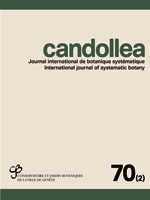Ferrer-Gallego, P. P. (2015). Lectotypification of Papaver cambricum L. (Papaveraceae). Candollea 70: 207–210. In English, English abstract. DOI: http://dx.doi.org/10.15553/c2015v702a5
The typification of the name Papaver cambricum L. (Papaveraceae) is discussed. This species was previously accepted in the genus Meconopsis Vig. as Meconopsis cambrica (L.) Vig. The protologue of the name and the original material are evaluated. A specimen from the Burser Herbarium (UPS-BURSER) is designated as the lectotype.
Introduction
The genus Meconopsis Vig. (Papaveraceae) comprises approximately 70 perennial monocarpic or polycarpic herbs, distributed primarily in southern central Asia (Grey-Wilson, 2014). The western European M. cambrica (L.) Vig. was long considered to be the only European representative of the genus. However, new molecular studies suggest that it does not belong to the Asian species of Meconopsis but should rather be accepted in Papaver L. (Kadereit et al., 1997, 2011; Carolan et al., 2006). As Meconopsis cambrica was the original type of Meconopsis, the genus would have been considered as a synonym of Papaver and therefore left the Asian species without a generic name. Grey-Wilson (2012) further proposed the name Meconopsis for conservation with a proposed conserved type: M. regia G. Taylor. This proposal was strongly recommended by the Nomenclature Committee for Vascular Plants (Applequist, 2013).
Meanwhile, Grey-Wilson (2014) placed Papaver cambricum L. in the monotypical genus Parameconopsis Grey-Wilson.
However, the name Papaver cambricum L. has not yet been typified (Jarvis, 2007: 722). This paper proposes the designation of a lectotype for this name based on the protologue and consultation of Linnaeus's original material.
Typification
The protologue of P. cambricum (Linnaeus, 1753: 508) presents four synonyms. The first synonym is cited from Linnaeus (1738: 201) and Royen (1740: 479) “Papaver foliis pinnatis, fructu acuminato”, the second from Dillenius (1732: 300, t. 223, f. 290) “Papaver cambricum perenne, flore sulphureo”, the third from Morison (1680: 279, s. 3, t. 14, f. 12) “Argemone cambro-britannica lutea, capite longiore glabro”, and the fourth from Bauhin (1620: 92, 1623: 171) “Papaver erraticum pyrenaicum, flore flavo”. “Burs. IX: 45” is the citation of a specimen in UPS-BURSER (Herb. Burser IX: 45), which is therefore a syntype. Two of the synonyms are accompanied by illustrations (Morison, 1680; Dillenius, 1732), which are also original material.
Linnaeus's original material additionally includes two uncited specimens (Jarvis, 2007: 723). At LINN, the specimen “Herb. Linn. No. 669.9” bears the annotation “7 cambricum” by Linnaeus, explicitly referring to the number of the species account of P. cambricum in Linnaeus (1753: 508) (see Stearn, 1957;Turland & Jarvis, 1997;Turland, 2006; Jarvis, 2007: 41–46, 397). The specimen is a stem with leaves, a flower and a flower bud, but no fruit.
The sheet preserved in the Clifford Herbarium, “Herb. Clifford: 201”, Papaver 4 (BM000628706) is annotated “Papaver erraticum pyrenaicum flore flavo C.B.P. 171 / Papaver foliis pinnatis, fructu acuminato H. C1. IV. p. 201”. The specimen is a stem with leaves and three flowers, but no fruit.
Finally, the syntype in UPS-BURSER bears two fragments, one with a flower, the other with a flower bud, and a label with the annotation “Papaver erraticum pyrenaicum flore flavo Bauh./ In Pyrenaeis” (see Savage, 1937: 27). No further original material have been found in any of the other Linnaean and Linnaean-linked herbaria.
The specimen in UPS-BURSER has precedence in lectotype designation over the uncited specimens and cited illustrations. It is therefore the obligate lectotype and must be designated as such. Fortunately it is in a good state of preservation, and it conforms with the other Linnean specimens and illustrations and with the traditional and current use of the names P. cambricum and Meconopsis cambrica.
Acknowledgements
The author thanks Dr. Mats Hjertson (Museum of Evolution, Botany Section Uppsala University, Sweden) for his help as well as an anonymous reviewer.






